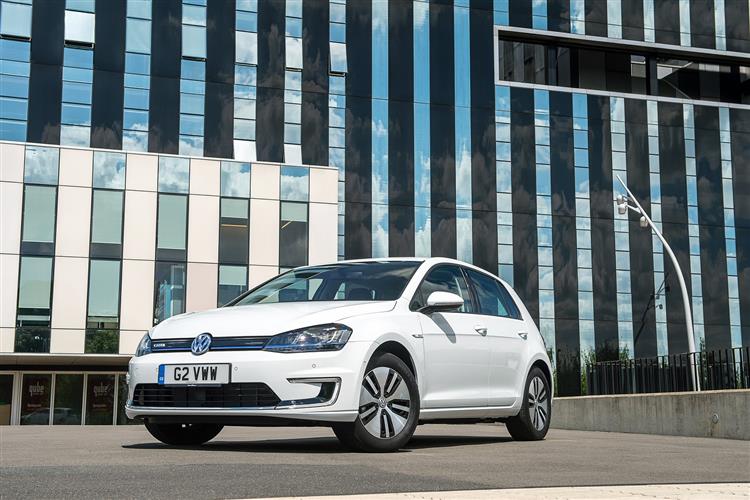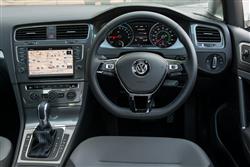E BY THRUM (some text hidden) --NONE--
B Jonathan
Introductionword count: 62
Volkswagen's first foray into EV motoring came back in 2014 with this model, the e-Golf. Subtle styling hides impressive technology that's easy to use in ordinary motoring. With zero emissions come big savings and with later versions, there's a reasonable driving range between charges for the standards of compact EVs in the 2014-2020 period. Still want that used turbo diesel family hatch?
Modelsword count: 5
Models Covered: 5dr Hatch (EV)
Historyword count: 240
Before the launch of this model in the Spring of 2014, electric motion was associated with the kind of extrovert futuristic design you saw on cars like the Nissan LEAF and the BMW i3. Volkswagen could have done that too but instead, opted to try for something far more challenging: the creation of an all-electric car that looked and felt identical to a conventional one. The seventh generation Golf was developed from the start with this goal in mind, its unique MQB platform flexible enough to make this Volkswagen the first car available with no fewer than five different types of power source. The 'CNG' 'Compressed Natural Gas' version was never made available here but alongside this e-Golf, we did get a petrol/electric GTE Plug-in hybrid model as well as the conventional petrol and diesel versions. It was quite a line-up. Creating this version though, challenged Volkswagen's designers more than any other. Its launch was the culmination of 38 years of development, the first electric Golf prototype dating all the way back to 1976. That car though, only developed 25PS and managed just 43 miles between charges. This one of course was very different. The initial 115hp version launched in 2014 managed 118 miles between charges. Volkswagen improved it in 2017, the updated 136hp version increasing battery range to 188 miles. The e-Golf shuffled off to the showroom in the sky in 2020 to make way for the Volkswagen ID.3.
What You Getword count: 502
These days, the choice you have to make in buying an affordable used family-sized all-electric car is fairly clear. Must you display your eco-consciousness overtly and buy, say, a BMW i3 or a Nissan LEAF? Or will you be content to keep your planet-saving preferences to yourself and drive something like this, a Golf that. well looks like any other Golf Inside, as with the exterior, the message is very clear: 'yes, this car is electrically powered but otherwise, it's just like any other Golf: carry on as usual'. A multifunction screen between the binnacle's two main dials shows your remaining range on electric power, as well as bringing all the various infotainment functions directly into your line of vision with neat carousel-type graphics. These features are more easily accessed via the 'Discover Navigation Pro' central infotainment screen, an 8.0-inch touch-sensitive display that dominates the centre of the dash. This central fascia screen also includes a range of so-called 'e-displays', one of them a beautifully detailed 'Power flow' graphic. In addition, you get a 'Range monitor' showing more clearly how far you can drive on electric power. And there's also a graphical 'Regeneration' screen charting for you how much of the charge used on your journey has been created by regenerative braking. And the back seat? Well, space around it doesn't appear to have been compromised by the large battery pack that must sit beneath. As with any normal five-door Golf, there's decent leg and knee room for this class of car thanks to the 53mm wheelbase increase delivered by the hi-tech MQB platform. Shoulder and elbow-room are both also reasonable and headroom's quite adequate. The result is the usual spacial compromise you get in this class of car, so comfortable room for two adults or three kids, but nothing more. Things would be better were it not for the kind of high central transmission tunnel you'd think you wouldn't need on an all-electric front wheel drive car. Most all-electric cars though, manage to achieve decent rear seat packaging without too many compromises. Where a lot of them struggle though, is when it comes to boot space. After all, the bulky battery cells have to sit somewhere. Here fortunately, the effect of was minimal - and certainly a lot more minimal than it is with a Golf GTE Plug-in hybrid, where bootspace falls from the 380-litre figure you'd get in a normal model to just 272-litres, less than is offered by the brand's Polo supermini. With an e-Golf, there are far fewer sacrifices to be made in this regard. Boot space here falls only slightly against the standard version - to 341-litres, which is actually the same as you get in a Golf R hot hatch and significantly more than you get in direct rivals like BMW's i3. Pushing forward the backrest doesn't reveal a completely flat floor, but there's enough space to compensate for the fact that Volkswagen didn't offer an estate version of this variant, the total figure being 1231-litres.
To see the full road test text contact us on 0330 0020 227
Pictures (high res disabled)

.jpg)
|
.jpg)
|
.jpg)
| |||
.jpg)
|
.jpg)
|
.jpg)
| |||
.jpg)
|

|
Scoring (subset of scores)
Category: Hybrid, Plug-in, Electric & Hydrogen
| Performance | |
| Handling | |
| Comfort | |
| Space | |
| Styling, Build, Value, Equipment, Depreciation, Handling, Insurance and Total scores are available with our full data feed. | |



